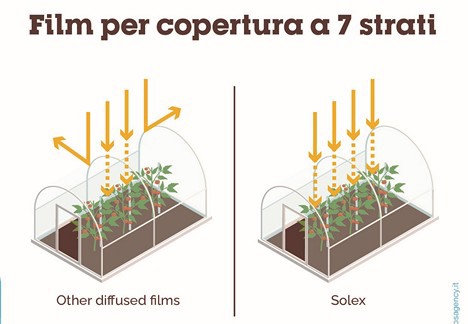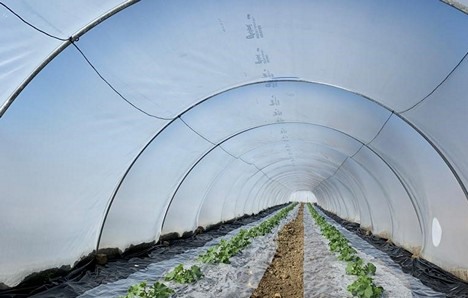The control of light and climate is essential in greenhouse cultivation. The interaction between the two factors exerts a major influence on the size and quality of the harvest. Is there a plastic film with light transmission that does not compromise greenhouse temperature control? We put the question to Emanuele Garrasi, CEO of Italy's Agriplast.

On the left, you can see how a standard plastic film works; on the right, how Solex allows greater light penetration, thus improving the performance of crops.
"In warmer areas and with crops that are more sensitive to heat, the most common solution is to use matte plastic film. The penetration of solar radiation is reduced, and with it, the temperature in the greenhouse," Garrasi replied. "However, the benefit of reducing the heat in the greenhouse also leads to a decrease in plant productivity because photosynthesis is lower because of the scarce light."
Plastic film with hollow microspheres
"To implement the opacity effect in the plastic film, it is common to use mineral fillers. These are very small particles with a filter function for solar radiation, which, therefore, also reduces sunlight in the greenhouse. We have patented an alternative solution that is the right compromise. The mineral fillers are replaced by hollow microspheres made of glass," adds Agriplast's CEO.
 Polytunnel covered with Solex.
Polytunnel covered with Solex.
"This film, called Solex, maintains very high transparency while providing excellent thermal insulation. Solex allows the sun's rays to pass through almost completely but deflects their path and prevents direct incidence on the plants. Moreover, the microspheres are themselves a thermal insulator, so even sudden temperature changes are smoothed out."
 Polytunnel covered with Solex.
Polytunnel covered with Solex.
"The results are remarkable. The large amount of light available to the plants and the controlled temperatures increase photosynthesis and, consequently, plant productivity. The distance between the internodes also decreases, resulting in better plant health and greater resistance to fungi and viruses," concludes Garrasi.
For more information: ![]()
Agriplast S.p.A.
Via Filippo Bonetta 35
97109 - Vittoria (RG) - Italy
Tel.: +39 0932 997211
[email protected]
https://www.agriplast.com
